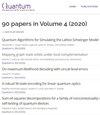Holevo cramsamr - rao bound:在不纠缠测量的情况下,我们能有多接近?
IF 5.1
2区 物理与天体物理
Q1 PHYSICS, MULTIDISCIPLINARY
引用次数: 0
摘要
在多参数量子计量中,纠缠资源可以提高估计过程的效率。纠缠可以用于状态准备阶段,或测量阶段,或两者兼而有之,以利用这一优势;这里我们着重讨论纠缠测量的作用。具体来说,已知对探针状态的多个相同副本进行纠缠或集体测量优于单独测量每个探针,但是这种改进的程度是一个开放的问题。众所周知,这种纠缠测量虽然资源密集,但在多参数量子计量和量子信息处理任务中需要达到极限。在这项工作中,我们研究了集体量子测量在估计量子位态参数方面可以提供的最大精度改进,称之为“集体量子增强”。我们表明,虽然最大增强原则上可以是估计n个参数的n个因子,但对于较大的n个参数,这个界限并不紧。相反,我们的结果证明了qudit维度的线性增强是可能使用集体测量的,并使我们推测这是任何局部估计场景中最大的集体量子增强。本文章由计算机程序翻译,如有差异,请以英文原文为准。
Holevo Cramér-Rao bound: How close can we get without entangling measurements?
In multi-parameter quantum metrology, the resource of entanglement can lead to an increase in efficiency of the estimation process. Entanglement can be used in the state preparation stage, or the measurement stage, or both, to harness this advantage; here we focus on the role of entangling measurements. Specifically, entangling or collective measurements over multiple identical copies of a probe state are known to be superior to measuring each probe individually, but the extent of this improvement is an open problem. It is also known that such entangling measurements, though resource-intensive, are required to attain the ultimate limits in multi-parameter quantum metrology and quantum information processing tasks. In this work we investigate the maximum precision improvement that collective quantum measurements can offer over individual measurements for estimating parameters of qudit states, calling this the 'collective quantum enhancement'. We show that, whereas the maximum enhancement can, in principle, be a factor of $n$ for estimating $n$ parameters, this bound is not tight for large $n$. Instead, our results prove an enhancement linear in dimension of the qudit is possible using collective measurements and lead us to conjecture that this is the maximum collective quantum enhancement in any local estimation scenario.
求助全文
通过发布文献求助,成功后即可免费获取论文全文。
去求助
来源期刊

Quantum
Physics and Astronomy-Physics and Astronomy (miscellaneous)
CiteScore
9.20
自引率
10.90%
发文量
241
审稿时长
16 weeks
期刊介绍:
Quantum is an open-access peer-reviewed journal for quantum science and related fields. Quantum is non-profit and community-run: an effort by researchers and for researchers to make science more open and publishing more transparent and efficient.
 求助内容:
求助内容: 应助结果提醒方式:
应助结果提醒方式:


